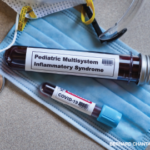Since the beginning of the COVID-19 pandemic, the majority of serious and life-threatening outcomes have occurred in adults. But in late April, clinicians in the U.K. reported a cluster of previously healthy children who presented with cardiovascular shock, fever and hyperinflammation. On May 14, the Centers for Disease Control & Prevention (CDC) issued a national health advisory to report cases meeting the criteria for multisystem inflammatory syndrome in children (MIS-C).

Dr. Jay Mehta
Jay Mehta, MD, attending physician in the Division of Rheumatology and director of the Pediatric Rheumatology Fellowship Program at the Children’s Hospital of Philadelphia (CHOP), reports that his hospital received many calls from worried pediatricians and emergency department physicians asking for advice on how to diagnose and treat these patients.
Charged with chairing the ACR COVID-19 Pediatric Rheumatology Clinical Guidance Task Force, Dr. Mehta realized the the recommendations for MIS-C would differ from general recommendations targeted to SARS-CoV-2- exposed children with rheumatic disease who did not exhibit inflammatory syndromes and that specific diagnostic pathways could provide better guidance for clinicians. He helped convene a second task force, which in less than a month has now prepared a clinical guidance document specific for MIS-C associated with SARS-CoV-2 and hyperinflammation in COVID-19.
Developing Guidance Statements

Dr. Lauren Henderson
Lauren Henderson, MD, MMSc, an attending physician at Boston Children’s Hospital and assistant professor of pediatrics, Harvard Medical School, Boston, was chosen to lead the MIS-C task force, because she has experience developing treatment guidelines for children with hyperinflammatory syndromes and had seen numerous children with MIS-C.
The multidisciplinary task force included nine pediatric rheumatologists, two adult rheumatologists, two pediatric cardiologists, two pediatric infectious disease specialists and one pediatric critical care physician. During an initial webinar on May 22, the participants divided into four work groups to address different topic areas, such as the diagnostic evaluation of MIS-C, cardiac management and the role for immunomodulatory treatment. Each work group took a week to gather data for its evidence reports and to develop preliminary statements or recommendations. Those statements were submitted to the group at large for voting.
Similar to the general pediatric task force, the MIS-C task force built consensus through a modified Delphi process involving two rounds of anonymous voting and two webinars for discussion of anonymous voting results. A 9-point scale was used to determine the appropriateness of guidance statements, with 1 = inappropriate and 9 = appropriate.
MIS-C Distinct from Kawasaki Disease
Dr. Mehta notes that MIS-C case definitions from the CDC and the World Health Organization were “very broad, because they were designed for reporting cases rather than diagnostic purposes.” The task force relied on many sources of evidence and clinical pathways from several institutions, including the CHOP MIS-C clinical pathway, to develop their guidance.
As many early cases of MIS-C appeared, reports noted the clinical features closely resembled those seen with Kawasaki disease. Overlapping features include fever; conjunctival injection; oropharyngeal symptoms, such as red or cracked lips and strawberry tongue; rash; and cervical lymphadenopathy. The clinical guidance document specifies the ways in which MIS-C cases associated with SARS-CoV-2 differ from Kawasaki disease. For example, MIS-C patients exhibit a broader age range, and those with Kawasaki disease tend to be younger. MIS-C patients are more likely to display cardiac dysfunction, to have prominent gastrointestinal and neurologic symptoms and to present in shock.
Dr. Henderson also points out that Kawasaki disease is most common in those of East Asian descent, while cases of MIS-C are more common in patients of Afro-Caribbean and possibly Hispanic descent. “There may be biologic factors that explain this, or it may be due to socioeconomic factors and thus greater exposure to SARS-CoV-2,” she says. More research is needed to supply answers to these observed patterns.
A Stepped Approach
The task force reiterated that the majority of children with COVID-19 have mild symptoms and excellent outcomes. In fact, the group achieved consensus on outpatient evaluation for children with stable vital signs, provided physicians ensure close follow-up. However, MIS-C patients who develop additional symptoms, such as tachycardia, respiratory distress, evidence of mild renal or hepatic injury or other abnormal laboratory findings, should be considered for hospital admission. The guidance document includes a tiered diagnostic workup to aid in staging these patients, says Dr. Mehta.
Patients admitted to the hospital should be evaluated by specialists with expertise in MIS-C and managed by a multidisciplinary team, Dr. Henderson emphasized. The guidance document supplies specific advice regarding cardiac management. Moderate to high consensus was achieved on most of the directives regarding cardiac imaging intervals and what each should include. For example, a high measure of consensus was achieved for echocardiograms to be conducted at diagnosis and during clinical follow-up to evaluate ventricular/valvular function, pericardial effusion and coronary artery dimensions with measurements indexed to body surface area using z-scores.
The document also includes guidance regarding immunomodulatory and anticoagulation treatment in MIS-C and when and how biologics may be introduced. MIS-C treatment may include low- to moderate-dose glucocorticoids, or high-dose, intravenous pulse glucocorticoids in patients with life-threatening complications, such as shock. It also gives specifics on timing, dosages and testing.
Key Messages Emphasized
Dr. Henderson was on service at Boston Children’s Hospital during the first wave of East Coast pandemic cases. “We saw quite a lot of MIS-C patients, and I cared for them on the week that we were the busiest,” she recalls. She and her colleagues from Boston Children’s have developed a manuscript summarizing their experience with more than 30 MIS-C patients. “Fortunately,” she says, “the patients all did very well and got better fairly quickly.” This is a message that’s also embedded in the guidance document: The vast majority of children with COVID-19 present with mild symptoms, and MIS-C remains a rare complication.
However, she adds, the field is evolving, and our knowledge of MIS-C will change over time. Understandably, patients’ families and frontline emergency and pediatric physicians voice worry and concern when the syndrome develops in their patients.
Although there is still a lot we don’t know, Dr. Mehta says, “I’ve been telling my patients that our data are showing that patients with rheumatic disease or immunosuppression are generally doing very well. On a population level, we are not seeing bad outcomes.” The current clinical guidance documents may offer an additional benefit for pediatric rheumatologists who practice in outlying areas, he says. “Even if they are not in a hot spot, they can find their closest colleague and ask for an opinion.”
Gretchen Henkel is a health and medical journalist based in California.



